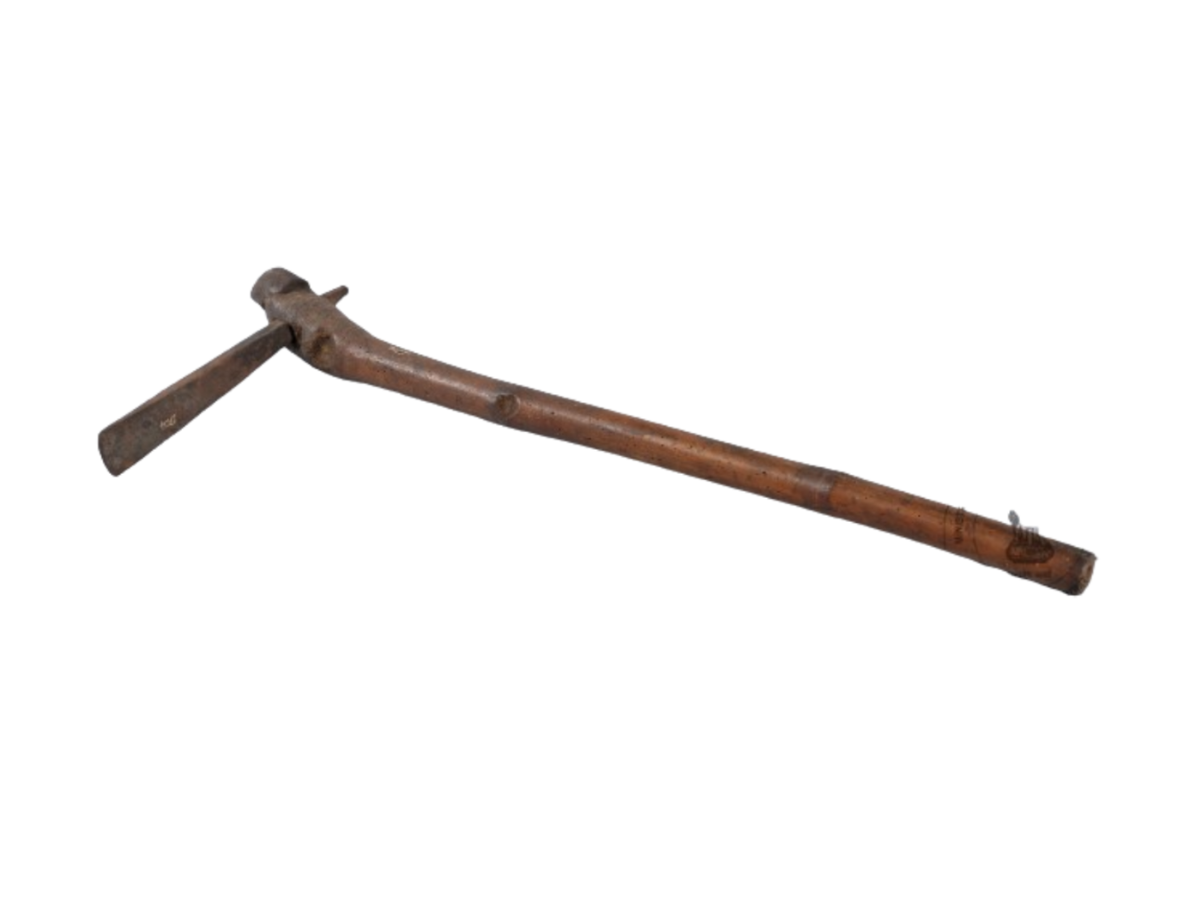State
Tribe Name
Art Type
short description
Assam's Karbi tribe has always enjoyed a reputation for the traditional tools used in agriculture. The tool in question-a bamboo handle with an iron blade-is a fine expression of the ingenuity of the tribe and its thorough knowledge of local resources.
This instrument is characterized by an iron blade, nearly triangular in shape, fitted into the rounded blunt front end of a bamboo shaft. The blade has a straight cutting edge on the working side to facilitate efficient cutting and scraping in agriculture and domestic uses. The front end of the bamboo handle slightly bends, with a natural node forming a strong point for the secure embedding of the blade's tang. This design thus ensures durability and efficiency, enabling this tool to withstand severe beating. Thus, their knowledge of bamboo far exceeds that involved in tool-making. Bamboo provides for their daily sustenance: the making of houses, household utensils, and objects of cultic significance. This knowledge encompasses the harvesting of suitable bamboo culms, those that are about one to two years in age, giving maximum strength and flexibility. The bamboos are then cut with a barmok (long knife-a multipurpose tool), and the bottom part is kept free of any nodes, because that is considered vital for different crafts.
Recording traditional tools and methods of their use is crucial for the sustenance and maintenance of Karbi cultural heritage. Traditional tools and methods also testify to indigenous knowledge systems that are sustained with natural resource use for generations. The increasing encroachment of modernity has stirred exemplary recognition and value for such arts in the cause of promoting cultural diversity and sustainable means of livelihood.
This instrument is characterized by an iron blade, nearly triangular in shape, fitted into the rounded blunt front end of a bamboo shaft. The blade has a straight cutting edge on the working side to facilitate efficient cutting and scraping in agriculture and domestic uses. The front end of the bamboo handle slightly bends, with a natural node forming a strong point for the secure embedding of the blade's tang. This design thus ensures durability and efficiency, enabling this tool to withstand severe beating. Thus, their knowledge of bamboo far exceeds that involved in tool-making. Bamboo provides for their daily sustenance: the making of houses, household utensils, and objects of cultic significance. This knowledge encompasses the harvesting of suitable bamboo culms, those that are about one to two years in age, giving maximum strength and flexibility. The bamboos are then cut with a barmok (long knife-a multipurpose tool), and the bottom part is kept free of any nodes, because that is considered vital for different crafts.
Recording traditional tools and methods of their use is crucial for the sustenance and maintenance of Karbi cultural heritage. Traditional tools and methods also testify to indigenous knowledge systems that are sustained with natural resource use for generations. The increasing encroachment of modernity has stirred exemplary recognition and value for such arts in the cause of promoting cultural diversity and sustainable means of livelihood.
Thumbnail

Filter Postion
Right
Filter Background
Off
Theme
Filter Header Image

content
Image

description
Assam's Karbi tribe has always enjoyed a reputation for the traditional tools used in agriculture. The tool in question-a bamboo handle with an iron blade-is a fine expression of the ingenuity of the tribe and its thorough knowledge of local resources.
This instrument is characterized by an iron blade, nearly triangular in shape, fitted into the rounded blunt front end of a bamboo shaft. The blade has a straight cutting edge on the working side to facilitate efficient cutting and scraping in agriculture and domestic uses. The front end of the bamboo handle slightly bends, with a natural node forming a strong point for the secure embedding of the blade's tang. This design thus ensures durability and efficiency, enabling this tool to withstand severe beating. Thus, their knowledge of bamboo far exceeds that involved in tool-making. Bamboo provides for their daily sustenance: the making of houses, household utensils, and objects of cultic significance. This knowledge encompasses the harvesting of suitable bamboo culms, those that are about one to two years in age, giving maximum strength and flexibility. The bamboos are then cut with a barmok (long knife-a multipurpose tool), and the bottom part is kept free of any nodes, because that is considered vital for different crafts.
Recording traditional tools and methods of their use is crucial for the sustenance and maintenance of Karbi cultural heritage. Traditional tools and methods also testify to indigenous knowledge systems that are sustained with natural resource use for generations. The increasing encroachment of modernity has stirred exemplary recognition and value for such arts in the cause of promoting cultural diversity and sustainable means of livelihood.
This instrument is characterized by an iron blade, nearly triangular in shape, fitted into the rounded blunt front end of a bamboo shaft. The blade has a straight cutting edge on the working side to facilitate efficient cutting and scraping in agriculture and domestic uses. The front end of the bamboo handle slightly bends, with a natural node forming a strong point for the secure embedding of the blade's tang. This design thus ensures durability and efficiency, enabling this tool to withstand severe beating. Thus, their knowledge of bamboo far exceeds that involved in tool-making. Bamboo provides for their daily sustenance: the making of houses, household utensils, and objects of cultic significance. This knowledge encompasses the harvesting of suitable bamboo culms, those that are about one to two years in age, giving maximum strength and flexibility. The bamboos are then cut with a barmok (long knife-a multipurpose tool), and the bottom part is kept free of any nodes, because that is considered vital for different crafts.
Recording traditional tools and methods of their use is crucial for the sustenance and maintenance of Karbi cultural heritage. Traditional tools and methods also testify to indigenous knowledge systems that are sustained with natural resource use for generations. The increasing encroachment of modernity has stirred exemplary recognition and value for such arts in the cause of promoting cultural diversity and sustainable means of livelihood.
Image Mode
landscape
promoted
Off
Verified
Off
